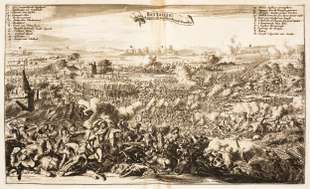Battle of Seneffe
| Battle of Seneffe | |||||||
|---|---|---|---|---|---|---|---|
| Part of the Franco-Dutch War | |||||||
The Duke of Enghien saving his father, the Grand Condé at the battle of Seneffe: painting from 1786 by Bénigne Gagneraux | |||||||
| |||||||
| Belligerents | |||||||
|
|
| ||||||
| Commanders and leaders | |||||||
|
|
| ||||||
| Strength | |||||||
|
44,200 30,000 infantry 14,200 cavalry 60 guns |
62,000 40,000 infantry 22,000 cavalry ~70 guns[2] | ||||||
| Casualties and losses | |||||||
|
6,000 killed and wounded 4,000 captured |
8,600 killed and wounded 5,400 captured | ||||||
The Battle of Seneffe was fought on 11 August 1674 between a French army under the command of Louis II de Bourbon, Prince de Condé and the Dutch-German-Spanish army under the Dutch Stadtholder William III of Orange (later King William III of England).
During the Franco-Dutch War, William commanded a Dutch-German-Spanish army through the southern Netherlands into the territory of Northern France. France defended this area with an army under "le Grand Condé". For five weeks the two armies manoeuvred without getting into combat with each other. On the 10th of August, William III decided to head towards Paris in order to force the enemy into fighting.
Condé sent a detachment of about 500 horsemen to keep the Dutch vanguard busy near the village of Seneffe, blocking the advance of William. In the meantime, Condé tried to surround the 62,000 allied troops with the 44,000 men at his disposal.
The horsemen managed to keep the Dutch vanguard busy, but the envelopment of the main allied force failed. After ten hours Condé had suffered 10,000 casualties and William - 14,000, with the allied troops retreating from the battlefield.

.png)
Citations
- ↑ Lynn, p. 80-81
- 1 2 Lynn, p. 126
- 1 2 Nimwegen 2010, p. 380.
- 1 2 Bodart 1908, p. 95.
References
- Bodart, G. (1908). Militär-historisches Kriegs-Lexikon (1618-1905).
- Lynn, John A. The Wars of Louis XIV, 1667–1714. Longman, (1999). ISBN 0-582-05629-2
- Nimwegen, Olaf van (2010). The Dutch Army and the Military Revolutions, 1588-1688. Translated by May, Andrew. The Boydell Press. 380
Further reading
- A New Military Dictionary: or, the Field of war. Containing a particular ... account of the most remarkable battles, sieges, bombardments, and expeditions, whether by sea, or land, such as relate to Great Britain ... from the descent of Julius Cæsar to the present time. Including anecdotes of ... admirals, generals, captains, &c ... To which is added, an essay on fortification, and a table, explaining the military and naval terms of art. Compiled ... by a Military Gentleman. Illustrated, etc. [With plates.]. J. Cooke. 1760. pp. 445–.
- The field of Mars. Printed for J. Macgowan. 1801. pp. 610–.
Coordinates: 50°31′43″N 4°15′35″E / 50.5287°N 4.2596°E